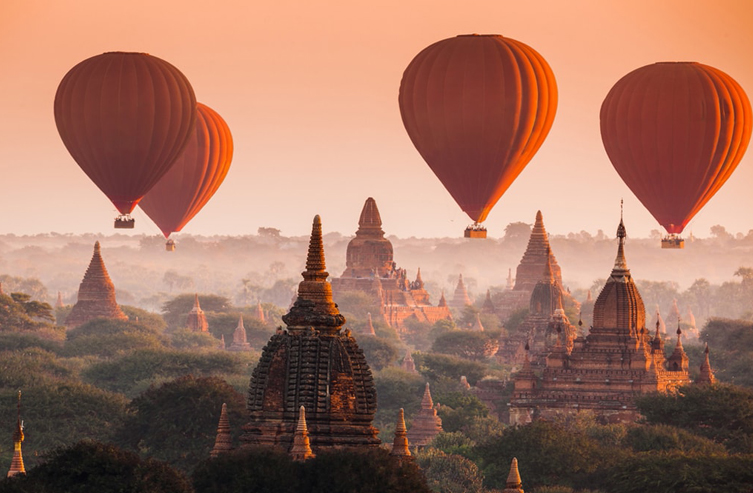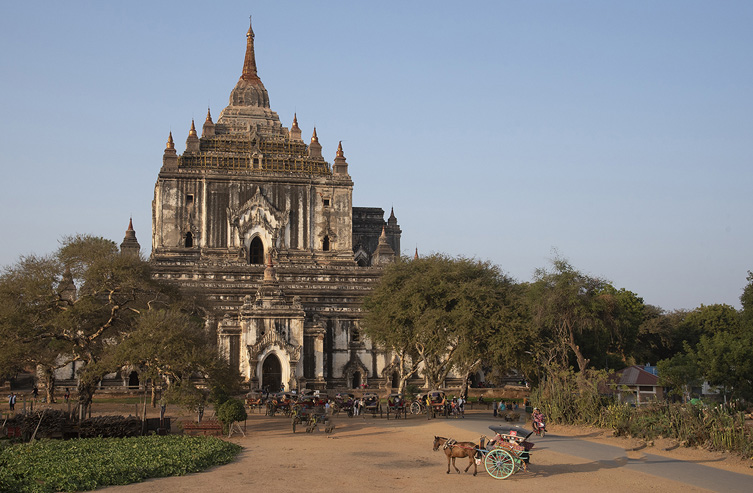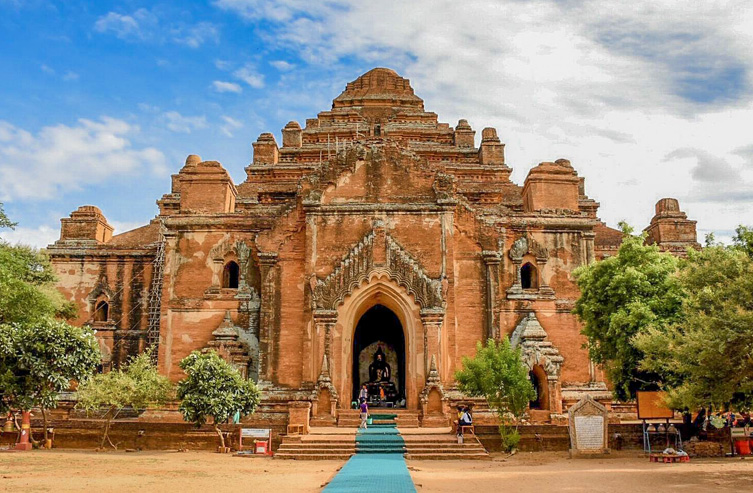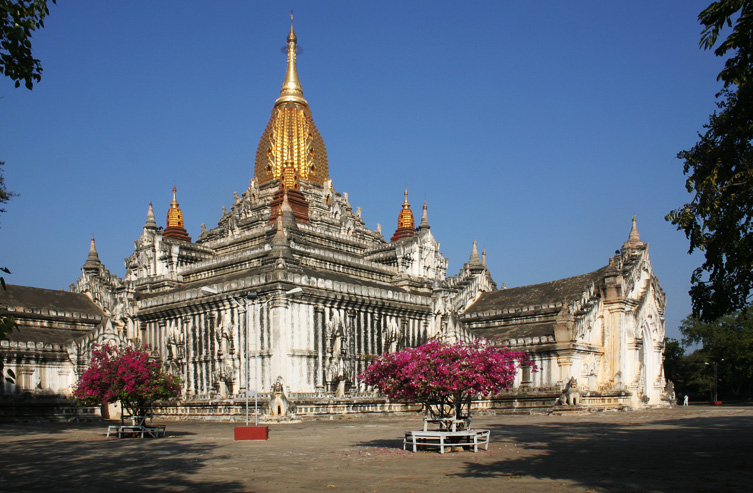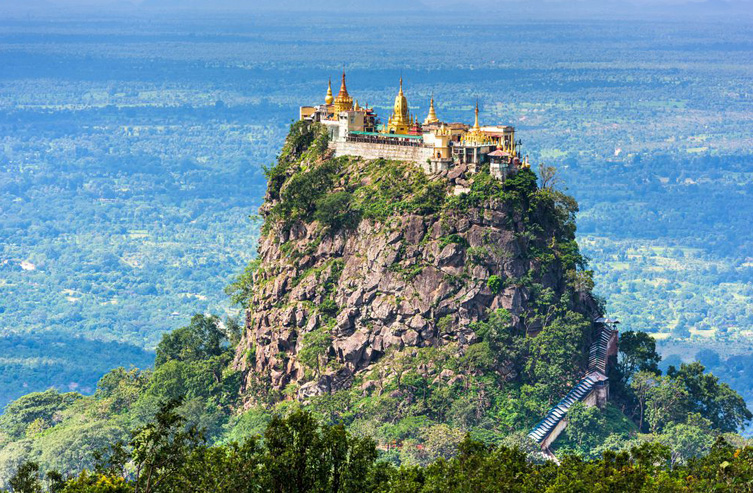Bagan is an ancient city that was the capital of the first Burmese empire. It is located in the dry central plains of the country, on the eastern bank of the Ayeyarwaddy River and approximately 90 miles (145 km) southwest of Mandalay. As the heart of Burma during ancient times, Bagan serves as home to temples and buildings was first built probably in AD 849 and from the 11th century to the end of the 13th century. According to the inventory of the Archaeological Department, there are 2217 standing pagodas. There are more than 2,000 pagodas and temples to be found, most of which were built by the ancient kings and leaders of Burma. In spite of adverse conditions weather for over a thousand year, destroying, the precious works of art, whatever survived to this day still thrill the beholders. Notable among the ancient glory are the big four, Shwezigone, Ananda, Thabyinnyu and Dhammayangyi.
After unifying the country, Anawrahta accomplished another noble deed for the country: he introduced Tharavada Buddhism into Myanmar with the help of Shin Arahan, a missionary monk from Thaton. It was Buddhism that influenced the rollers of Bagan Dynasty to build innumerable pagodas and temples in and around the city.
Among all the cities in Myanmar, Bagan is the most ideal destination for tourists to visit regardless of the time of the year. Unlike cities in the lower part of Myanmar, Bagan does not experience a rainy season and it is the perfect climate of Bagan that enables tourists to discover and explore the ancient city with ease all year round. Bagan may be an old city, but it does offer something fresh to its visitors. The endless pagodas stand testimony to the rich cultural heritage of the Myanmar’s and also to the beauty and grandeur of ancient pagodas.
Shwezigone Pagoda
The Shwezigon pagoda is located in the heart of a large area, surrounded by many temples and pagodas. Shwezigon pagoda was built during the reign of King Anawrahta, the founder of Bagan. The intention of the king when building Shwezigon pagoda is to store the relics of the Buddha. However, until the reign of Kyansittha in 1102, the construction was completed.
With outstanding, luxury and splendour architecture, many tourists coming to Myanmar commented that Shwezigon pagoda is similar to the famous Shwedagon Pagoda in Yangon. The Shwezigon pagoda is considered the prototype for all future architecture of pagodas and temples in Burma.
Unlike many other temples and pagodas in Bagan, which is built between the plains, Shwezigon pagoda is built on a sand dune (the meaning of Shwezigon is the pagoda on a sand dune). Shwezigon is considered the first and the most sacred gold pagoda in Myanmar.
That Byin Nyu Temple
The That Byin Nyu temple is located on a small hill near the Ananda temple and is the tallest temple in Bagan (61 meters), built under the reign of King Alaungsithu,in A.D 1144. There is a rhyme traditionally sung by the people of Bagan, which runs: ‘Massiveness that is Dhammayan Gyi, Loftiness that is Thabyinnyu, Grace that is Ananda.’ Dhammayan Gyi temple is the largest in massive size, Thatbyinnyu temple is the tallest in height, and Ananda temple is the most graceful with all artistic decorations. Thatbyinnyu, from the base to the finial is 201 feet high.
‘Thatbyinnyu’ means ‘Omniscience’ which the Lord Buddha attained on to become enlightened. This original name is one of the attributes of the Lord Buddha. Superficially, the vascular and white painted That Byin Nyu temple looks like a Christian monastery in renaissance in Europe. The That Byin Nyu temple is the mural painting museum of Buddhist art. Inside the temple are unique Buddhist statues.
Dhammayan Gyi Temple
The Dhammayangyi temple is located in the centre of Bagan. The Dhammayangyi temple was constructed by King Narathu in AD 1170 and un-finished it in 3 years. The king reigned only 3 years. The Dhammayangyi temple is famous for its large pyramid shape. This pyramid model is completely different from the structure of traditional temples and Buddhist temples of Myanmar.
According to some documents, although not completed, this temple has cost approximately 6 million bricks, not to mention the stone system as the basis for this massive building. There are four main entrances but only the outer corridors are accessible as the interior is blocked by brickworks for unknown reason. It has large porticoes in the centre of all four sides, forming the shape of Greek cross. At present, in the Dhammayangyi temple, there are many sealed rooms, tourists can only visit the corridor, the archway of the outer area.
Ananda Temple
Ananda Temple was constructed in Koza Sakarit 452 M. E (A. D. 1091) by King Kyansittha. It is known as the finest, largest, best preserved and most revered of the Bagan temples. The name of the temple has originated from the Venerable Ananda, Buddha’s first cousin. It was once known as Ananta Temple, deriving from the phrase ‘ananta pinya’ in Sanskrit, which translates as “endless wisdom”. According to legend, in the 11th century, 8 monks from India visited Bagan and were welcomed by King Kyansittha. They told him about a legendary cave located on Himalaya Mountain and about a very beautiful temple in the snow. King Kyansittha was so impressed by it that he commanded to build the Ananda temple, a model of “the temple in the snow” in deserted ancient Bagan, in 1091. It took 15 years for the temple to be completed.
Ananda Temple is like a museum. A lot of Myanmar arts here — architecture, stone sculpture, stucco, glazed plaques, terra cotta, wood carving, artwork of blacksmith etc. During earthquakes of 1975 and 2016, Ananda suffered considerable damage but has been totally restored. It looks stunning in the light of the setting sun.
Hot-Air Balloon Flight
Taking a hot-air balloon ride is the uncontested best way to see the thousands of temples scattered across the Plains of Bagan and provides an unforgettable experience.
Balloon tours normally begin at 6:30 am, just a few minutes after sunrise. They offer a bird’s-eye view of the monuments in the misty orange morning light. The picturesque spectacle of the temples at sunrise from red balloons above, has become iconic for travellers in Myanmar.
Hot-air balloon flight in Bagan normally cost around $330 per person and are seasonal (from October to March). Because the experience has become a crowd-favourite in recent years, tours should be booked well in advance. For more information on hot-air balloon flights in Bagan, travellers can look here.
Mt. Popa
Mount Popa, is an extinct volcano with a monastery on top, named the Popa Taungkalat, which means flower mountain rises about 1,500 meters above sea level. It is located in Central Burma about 180 kilometres South West of Mandalay and 50 kilometres South East of Bagan and Nyaung U airport. From either place it takes around 1 to 1½ hours by car to get there. The 777 steps of Mt. Popa are a pilgrimage site first and foremost, but it is equally famous for its monkey population which cheekily adorn the passageways. Although the region is very dry, the mountain and surrounding area are green and look like an oasis in the desert. As the volcanic soil is fertile and there are many streams in the area the mountain and National Park contain many beautiful flowers and other vegetation.
Mount Popa is the headquarters of Myanmar’s most powerful Nats and four of these Buddhist spirits worshiped by the Burmese are considered to have their home here. Statues of 37 of the spirits stand at the base of the mountain and, in years gone by, Burmese Kings commencing reign had to consult with the spirits such is their importance in Myanmar heritage.
One legend tells that King Anawrahta who founded the Bagan empire in the 11th century ordered a runner named Byatta to fetch fresh flowers from Mount Popa every day. One day Byatta met an ogress named Mai Wunna who lived on the mountain and ate only flowers. Byatta fell in love with her and soon after the ogress gave birth to two sons in a cave on Mount Popa.
According to the legend Byatta was executed and Mai Wunna died of a broken heart. Both became Nats that still live on the mountain today. When the two sons were later executed, they too became Nats. At Taungbyone near Mandalay an annual festival is held where the two brothers are worshipped.
Salay
Salay is a colorful old religious center in Central Myanmar it is about 120 kilometres north from Bagan. Salay, situated on the bank of Ayerwaddy River and which is the divergence of a number of religious sites such as temples, pagodas and monuments.
Visit the famous monastery "Yoke-Sone-Kyaung'' which is a cultural heritage site in Salay, which in situated on the eastern bank of the Ayeyarwaddy River. It is famous with its spectacular woodcarvings and it is the native town of the famous writer Salay U Pone Nya during the time of the Myanmar Kings. Salay Yoke Sone Kyaung was built in AD 1882. There are incredibly beautiful artistic work woodcarvings around it and also ancient Buddha image, utensils of Yadanabon 19 century period, and the museum of Myanmar famous writer U Pone Nya in Salay Yoke Sone Kyaung.
Salay House, which was a trading house in British Colonial times and built in 1906. This restored riverside warehouse is filled with antiques to recreate the flavour of this historic time period. Learn and explore how British-Burma operated with displays and information panels.

 (+95-9) 7757 30372
(+95-9) 7757 30372



